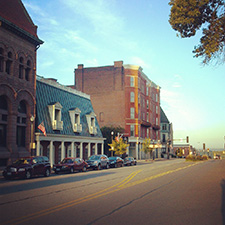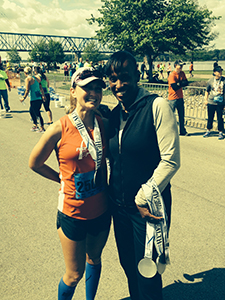Give Me Quincy
You can have your big cities, your New Yorks and Chicagos, your LAs and Londons. You can have your two-day, multi-million-dollar race expos, your Nike sponsorships, and your sold-out registrations. You can have your shuttles to the start line, your barricaded sidewalks, your miles of orange plastic fencing and runner reunite areas the size of Rhode Island (only alphabetized). You can have all that—and you should. The spectacle that is a major marathon is worth experiencing. After all, we all want to strut in the pageant.
But at the end of the day, give me Quincy.
 I’m beginning to think small towns know something the rest of us are missing. While the metropolises of the world are forever making their races bigger! and better! and louder! and blingy-er!—there is a faithful contingent of communities that sit in the contented shadows, accepting paper race registration forms. There, race expos are all of three hours long and fit within the snug confines of a basketball court (including an inflatable bounce house for the kids).
I’m beginning to think small towns know something the rest of us are missing. While the metropolises of the world are forever making their races bigger! and better! and louder! and blingy-er!—there is a faithful contingent of communities that sit in the contented shadows, accepting paper race registration forms. There, race expos are all of three hours long and fit within the snug confines of a basketball court (including an inflatable bounce house for the kids).
“Are you running tomorrow?” you may ask someone working one of the booths.
“Just the 5K. Are you running the half?”
“Yep.”
“Good luck!”
There, volunteers sit at a long folding table (maybe two) handing out race packets. There are no lines, and a familiar handshake is the only requirement for ID. Technically, packet pickup can be checked off within a matter of minutes. It rarely is. Familiar faces percolate through the gym doors, and you’ll want to say hi to Corey—the unofficial mayor of the runner’s club—and see if Doug picked up his packet yet and ask Nicholas how life’s been since he moved back and ask Karen about her marathon last month and find out that Ali is still vacationing in Mexico and will miss the race this year.
On race day, corrals are invisible and exist on the honor system: fast people up front, slow people in the back. If you’re lucky, Corey will execute mayoral duties with a brief state-of-the-course address, warning you about the quad-killer of a hill in the first fifty meters and the deceptiveness of the slope leading to and from the bridges.
“The hill coming off the second bridge is the worst because it’s so long,” he’ll caution you with a smile.
A resounding cannon explosion starts the race, and for the first twenty yards, you run blinded by the smoke. The first hill—as bad as it is—ends quickly enough. Then you remember Corey’s words. The hill after the second bridge. That’s the worst.
Spectators are numbered by the dozen, thrown about the course in handfuls—not because no one bothered to show up, but because everyone did and they’re all running. There are no giant stages with rock bands and screaming amps, but there is a mom and son in folding lawn chairs, sitting in front of a bank that hasn’t yet opened for the day, blasting the greatest party hits of the 90s and clapping as each runner filters by.  And what the spectators may lack in numbers they make up tenfold with impact—the lone bagpiper on the hill at mile four and Sarah, who recognizes you as she directs runners down the course, grabbing her phone from her pocket, and snapping a perfect, suspended-in-air, mid-stride photo.
And what the spectators may lack in numbers they make up tenfold with impact—the lone bagpiper on the hill at mile four and Sarah, who recognizes you as she directs runners down the course, grabbing her phone from her pocket, and snapping a perfect, suspended-in-air, mid-stride photo.
The course is fast—except for the hills hurled at you in the first four or five miles (and one more at mile seven). But no one complains about the mountainous climbs straight out of the gates. The Mississippi is mighty indeed, and as you cross from Illinois to Missouri and back again—the behemoth bridges hanging above the waters and soaring into an open sky—you begin to understand the locals’ cavalier attitudes. The hills are a small price to pay for the scenery. Plus, the second half of the course is almost flat (except for mile seven). The hills, well, they’re just part of the charm.
A trio of out-and-backs in the last six miles means constant encouragement and cheers from familiar faces. You finally see Karen—whom you missed at the expo—and Corey, who tells you that you’re looking strong. Letty shouts your name and cheers as you pass—as do several others runners around her, who are moved by her boisterous applause.
 When you cross the finish line, Jackie Joyner-Kersee is there to place your medal around your neck (try to get that at a big ol’ marathon). And speaking of big ol’ things—you should see the finisher’s medals at Quincy. They’d put most marathon hardware to shame. (Even small towns like their bling.)
When you cross the finish line, Jackie Joyner-Kersee is there to place your medal around your neck (try to get that at a big ol’ marathon). And speaking of big ol’ things—you should see the finisher’s medals at Quincy. They’d put most marathon hardware to shame. (Even small towns like their bling.)
After the race, everyone waits around to cheer on the finishers. The cheering continues long after the post-race bananas and granola bars are gone. Facebook. Texts. Emails. Congratulations abound. Sure, there are bigger races. Sure, they’ve all done them. But there’s something about small town races. It’s a community of runners in the most literal sense of the word.
And isn’t that how running should be?
Connect With Us
see the latest from Fleet Feet St. Louis